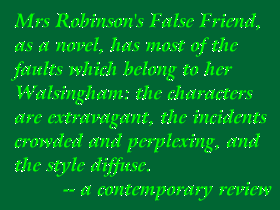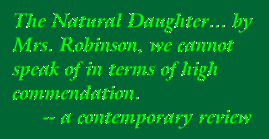


| [ Previous ] [ Next ] |

|
[Originally published, London: Longman and Reese, 1799. Reprinted in Mary Robinson, "A Letter to the Women of England" and "The Natural Daughter", ed. Sharon M. Setzer, Peterborough, Ontario: Broadview Press, 2003.]
This was Mary Robinson's final novel, published the year before her death -- i.e. the year after her final break-up with Tarleton -- and recently reprinted for the first time in a couple of centuries.
Bitter and barbed, it is hit-and-miss autobiographical. A variety of individual elements are clearly drawn from her life, but she has mixed things around and changed some points -- including the ending -- entirely. Ban and his family, personified as Gregory Leadenhead, a gung-ho young idiot, and his vulgar, social-climbing clan, are her most recognizable victims but others among her cast of nasties and morons must have been obvious caricatures to the readers of her time, or at least subjects for catty speculation. (I was certainly speculating about them as I read through...)

|
Mary did not have a happy life, and wasn't the least bit hesitant about blaming that fact on roughly everyone she had ever met. (A propensity which shines through in her memoirs and those few of her private letters I've had the opportunity to read.) Her alter-ego heroine, Martha, progresses through life with blameless and long-suffering perseverance, only to be constantly victimized by the wickedness or narrow-mindedness or selfishness of those around her. Utterly innocent (of anything except denseness and pride, anyway), Martha's attempt to be charitable to a foundling infant results in her being cast aside by her priggish, hypocritical husband and unsupportive family. Her attempts to earn an honest living -- as an actress, poet and author, in emulation of her literary Mama -- are overset by circumstances beyond her control, one after the other. The only one of her own professions which Mary does not settle upon her heroine is courtesan. Martha spends some time as a teacher instead, clinging nobly to her virtue in the face of all comers. (Perhaps the irrepressible Liz Armstead Fox could have given Mary a few pointers on how to be happy with her lifestyle choices.)
The plot seems fairly typical of its time period, though my acquaintance with 18th century novels -- and hence my grounds for comparison -- is severely limited. (I don't suppose Mary would have been at all flattered to know it puts me in mind of a PG-rated version of de Sade's Justine.) Martha's trials and tribulations weave through a loosely connected string of domestic events, many of them turning on enormous coincidences. Whether she's in Bath or atop a mountain in Switzerland, the woman cannot turn around without tripping over the entire cast, who have been dutifully trotting along in her wake, waiting for their next scene to arrive. To modern eyes, it's rather silly, but I imagine it was more acceptable to readers of her time. Mind you, her plotting ability didn't draw any particular praise then, either. In her introduction, Setzer quotes a contemporary review, probably written by Mary Wollstonecraft Godwin, of one of Mary's earlier novels to the effect that, "Mrs. Robinson writes so rapidly, that she scarcely gives herself time to digest her story into a plot." That criticism holds equally true for The Natural Daughter, though the rest of Wollstonecraft's accusation -- "[H]er sentences are often confused, entangled with superfluous words, half-expressed sentiments, and false ornaments." -- does not. Given the period when it was written, and Mary's propensity for poetry that has been squished flat by the sheer weight of adjectives, the text of this novel is surprisingly spare. The characters do suffer the odd fit of hysterical palpitations, but nowhere nearly so many of them as I was prepared to face. (Written when she was in poor health, it may be atypical of her work. Several of her previous novels were originally published in four volumes, whereas this one was only broken into two.) All in all, it's quite readable, albeit of interest for its caricatures or its feminist themes rather than as fiction.1
Those feminist themes are what brought the book back into print. A thread runs through it, highlighting the unfairness of the sexual inequality of the Georgian era -- particularly the way in which any breath of scandal could ruin a woman's reputation beyond repair while enhancing a man's. The other item in this reprint volume, A Letter to the Women of England on the Injustice of Mental Subordination is Mary's political treatise on the theme of sexual inequality, and has always been my favorite of her literary efforts. It may be derivative from Wollstonecraft's writings, but it indicates that there was an intelligent and forward-thinking mind buried beneath Mary's cloying self-absorption. Unfortunately, when she takes her feminism into the realm of fiction, the results just do not work for me. (Perhaps because I know too much about her life; perhaps not.) The novel reads more like a thinly disguised rendition of "oh, boo-hoo, look how mean everyone is to me" than a successful morality tale.

|
Feminist writers make a big point of how Mary's later work was hated by conservative male critics in its time -- hardly groundbreaking news -- but I haven't seen a decent analysis of how it was received by that portion of the population who more-or-less agreed with the message. (There may well be one out there in the zillions of literary magazines I haven't even heard of.) For anyone interested in following Setzer's viewpoint on Mary, she provides an extensive bibliography. Of course what I'd rather see is a collection of contemporary gossip about the book, wrt how various elements derive from real events and people, since that's my core of interest in it.
Speaking of its caricatures... Well, when Tarleton read the book -- and he must have read it -- I'm sure he wrote in large letters on his mental chalkboard: "NOTE TO SELF: NEVER-EVER-EVER GET INVOLVED WITH A WOMAN WHO CAN GET BACK AT YOU IN PRINT." I was surprised to discover that, despite the subtitle of "With Portraits of the Leadenhead Family" which was presumably stuck on to add fuel to the gossip-mill and potentially boost sales, Mary's poison-pen lampoons of her ex-lover and his relatives occupy quite a small portion of the text. The Leadenheads are drawn in hugely broad strokes, and with a style of wit as leaden as their name, but it would be marvelous to know which droplets of venom are exaggerated truth, and which are simply the acrimony of an embittered ex-wife, in practice if not in legal name. Hopefully -- for both their sakes -- she didn't think Ban was as dumb as Gregory throughout their whole fifteen years together. (Though admittedly that concept does prompt an amusing mental image of Mary wandering around, humming that old Julie Brown pop song with the chorus that ran "I like 'em big and... stupid. // I like 'em big and... real dumb." Possibly with minor variations in the words. Or not, depending.)
So now half of our curiosity about Mary's post-breakup literary output can be satisfied. Hopefully Broadview Press -- which has also reprinted a collection of her poems -- will eventually get around to returning The False Friend to availability, particularly if its editor improves on Setzer's example and includes a more illustrative sampling of contemporary reviews and reactions.
| [ Index ] | [ Previous ] [ Next ] |
1 Quoted pp18-19, from The Works of Mary Wollstonecraft, 7: 486. William Godwin, Wollstonecraft's husband, was a close friend of Mary's in later life -- too close, according to Setzer's notes, for Wollstonecraft's comfort. I don't know whether this contributed to the cattiness of the review. [ back ]
| Return to the Main Page | Last updated by the Webmaster on April 2, 2005 |